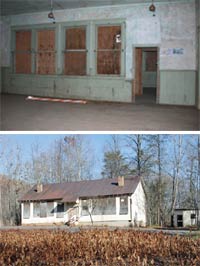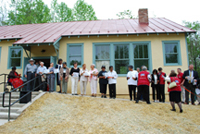Architecture/Renovation: A New Beginning for an Old School
 Scrabble School in 2008. Members
of the community who built
the school did a good job—the
building’s structure was still sound.
Scrabble School in 2008. Members
of the community who built
the school did a good job—the
building’s structure was still sound.  "This Place Matters"
Alumni proudly hold signs for the
National Trust for Historic Preservation
before a standing room only crowd at
the rededication of Scrabble School.
"This Place Matters"
Alumni proudly hold signs for the
National Trust for Historic Preservation
before a standing room only crowd at
the rededication of Scrabble School.As a brand new building in 1922, Scrabble School stood proudly as an example of a modern schoolhouse. Large windows to let in an abundance of natural light and fresh air, oak floorboards, slate blackboards, a kitchen, and storage rooms were innovative approaches meant to foster a healthy learning environment. Scrabble’s two-room schoolhouse was just one of the models the Rosenwald Fund’s architects designed. Their method mimicked the home kits of Sears Roebuck—Rosenwald’s company—that democratized homebuilding during the same period by lowering the cost to build.
The architectural plans and the Rosenwald Fund’s financial support started a process communities completed with fund drives and construction. In Scrabble's case, public funds paid for 34 percent of the school’s cost and white residents for less than 4 percent. The local African-American community contributed 33 percent—a third of the total expense—in order to better the lives of their children.
Several generations of African-American students attended Scrabble School. For one year following integration—1967-68—white children also attended Scrabble. At the end of that school year, Rappahannock County decided the two-room schoolhouse was inadequate and closed the school. The building became derelict as its architectural and historical significance was forgotten.
The same was true elsewhere. So few Rosenwald Schools remain that in 2002 the National Trust for Historic Preservation listed them among its “most endangered places.”
In 2009—forty years after it was abandoned—Scrabble School reopened as the Rappahannock Senior Center at Scrabble School and the Rappahannock African-American Heritage Center. That it has been spared is a testament to the efforts of many in our community—most notably E. Franklin Warner—who lived by the school’s motto: We can if we think we can.
Audio Recordings
-
Also replaced.